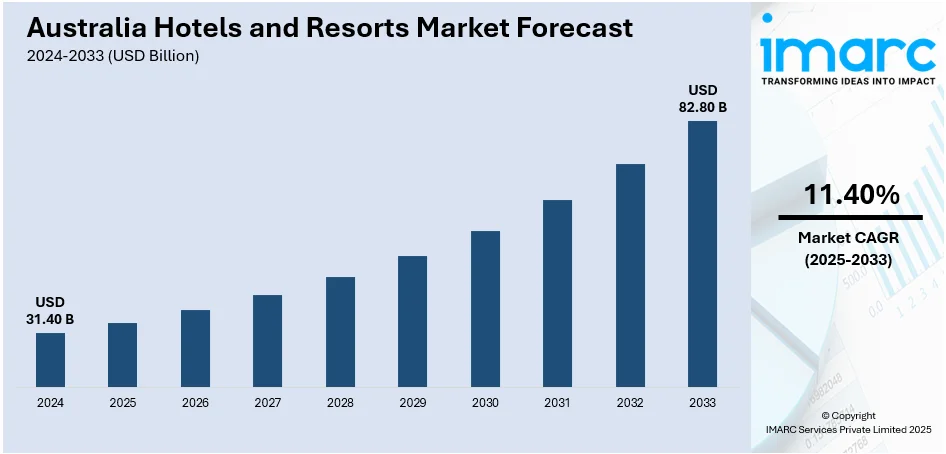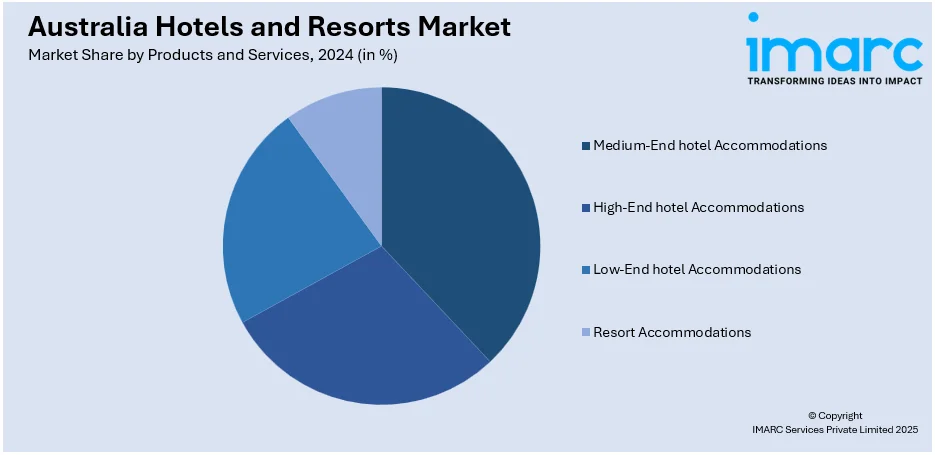
Australia Hotels and Resorts Market Size, Share, Trends, and Forecast by Products and Services and Region, 2025-2033
Australia Hotels and Resorts Market Overview:
The Australia hotels and resorts market size reached USD 31.40 Billion in 2024. Looking forward, the market is expected to reach USD 82.80 Billion by 2033, exhibiting a growth rate (CAGR) of 11.40% during 2025-2033. The market is steadily growing, driven by rising domestic and international tourism with increased investments in luxury and eco-friendly accommodations, and the integration of advanced digital technologies to enhance guest experiences and operational efficiency.
|
Report Attribute
|
Key Statistics
|
|---|---|
|
Base Year
|
2024 |
|
Forecast Years
|
2025-2033
|
|
Historical Years
|
2019-2024
|
| Market Size in 2024 | USD 31.40 Billion |
| Market Forecast in 2033 | USD 82.80 Billion |
| Market Growth Rate (2025-2033) | 11.40% |
Key Trends of Australia Hotels and Resorts Market:
Rising Popularity of Eco-Friendly and Sustainable Tourism
The Australia hotels and resorts market share is undergoing a significant transformation, aligning with the growing demand for eco-friendly and sustainable tourism. Travelers are prioritizing accommodations that uphold their values, particularly focusing on environmental sustainability to minimize their ecological footprint during their journeys. Hotels are highly adopting such sustainability ventures, such as energy-saving systems, waste minimizing programs, and renewable sources of energy. Eco-friendly architecture, water-conserving technologies, responsible sourcing of materials and food products which are standard in various establishments. This trend is driven by the inclination of hotels to comply with regulations to attract a growing number of environmentally aware travelers. For instance, in September 2024, Accor, a major hotel operator in Australia, announced the recipient of Sustainable Tourism Certification by Ecotourism Australia for its 100th hotel. This achievement will aid Accor in attaining its objective of having 100% of its network in Pacific region receive certification for sustainability by 2025 end. Moreover, Australian landscape, with its natural wonders, encourages eco-tourism and nature-centric experiences. Hotels incorporating these features into their operations, including providing eco-tours, supporting conservation efforts, and are collaborating with local communities to create unique, sustainable experiences for guests. This strengthens the appeal of the market and attracts ecotourism-minded travelers who place a premium on environmental responsibility during their visits.

To get more information on this market, Request Sample
Growing Demand for Experiential and Luxury Travel
The Australia hotels and resorts market growth is fueled by a surge in demand for experiential and luxury travel, prompting a shift toward accommodations that offer unique and immersive experiences for affluent tourists. This also includes activities, such as guided tours, culinary experiences, wellness and spa services, and cultural immersion programs. The "experience over product" trend is driving hotels and resorts to transition from traditional setups toward curated packages that prioritize memorable experiences tailored to guests with preferences and desires. Luxury travel growth is fueled by high premium room inventory in gateway destinations like Sydney, Melbourne, and the Gold Coast-the latter an essentially tropical destination with world-class attractions and cityscapes. The Great Barrier Reef and the Outback, tap into this trend by adding private island tours, snorkeling adventures, and customized nature walks to their resorts in natural destinations. Apart from this, the demand for luxury and experiential stays promotes investments in upscale properties and amenities, which are amplifying market competition. For instance, as per industry reports, luxury travel is notably rising across Asia Pacific, with travelers planning for longer holders. In line with this, Australia has emerged as a preferable destination, with 46% people visiting the nation.
Growth Factors of Australia Hotels and Resorts Market:
Domestic Tourism and Regional Travel Revival
One of the most significant growth drivers fueling the Australia hotels and resorts market demand is the consistent revival of domestic tourism, which has picked up momentum in recent times. As Australians continue to look inward and explore their own backyard, demand for regional and coastal accommodation has picked up pace. Locations like the Gold Coast, Margaret River, the Whitsundays, and Tasmania are now favorite spots for weekend breaks and longer holidays. Tourists are looking for experiential travel in natural surroundings, wine country, and heritage towns, and this has led hospitality operators to reinvest or increase facilities in these destinations. Regional tourism has also encouraged expansion in boutique hotels and ecotourism resorts, with many businesses adopting green and local cultural integration principles. Developments in road infrastructures and intra-regional air connectivity have increased access to previously remote locations. This shift toward domestic discovery has established a stable basis for sustained demand, even during times when international travel is uncertain or out of reach for most Australians.
Emergence of Staycations and Work-from-Hotels
One of the key drivers of growth in the Australian hotels and resorts sector is the growing popularity of staycations and the emergence of flexible work-from-hotel arrangements. Since the trend of remote work is rising, a lot of Australians are mixing work and leisure by opting for hotels that provide amenities for both. Due to this, there has been an upsurge of interest in such hotels that provide high-speed internet, quiet working areas, health benefits, and beautiful locations—offering a conducive yet relaxed environment. Hotels in destinations such as Byron Bay, the Sunshine Coast, and the Mornington Peninsula are getting in on the act by providing mid-week specials, long-stay rates, and wellness-featured packages designed for remote workers. The "bleisure" (business + leisure) travel trend is also increasing in popularity, especially from urban dwellers who want a break from city life without going far. These changing guest expectations are prompting hotel operators to reimagine services and amenities to serve the demands of a new, hybrid traveler—one who appreciates flexibility, convenience, and work-life balance under one roof.
Return of International Tourism and Business Travel
According to the Australia hotels and resorts market analysis, the easing return of international travel has given a substantial lift to the region’s markets, especially in urban and gateway locations. Sydney, Melbourne, and Brisbane are now again open to international tourists, including long-distance travelers from Asia, Europe, and North America. These travelers tend to stay for longer periods and spend more, boosting the high-end hotel and resort industries. The return of high-level international events, conferences, and cultural festivals is also fueling a pick-up in business travel and MICE tourism. Hotels near convention centers, business districts, and airports are witnessing renewed interest from corporate clients and international delegates. Moreover, Australia's stable political climate, attractive visa policies, and reputation as a safe destination make it particularly appealing for both leisure and business travelers. With airlines reinstating routes and tourism campaigns highlighting Australia's offbeat attractiveness, the hospitality industry is well-placed to benefit from this increased stream of tourists, driving long-term expansion at various levels of market.
Australia Hotels and Resorts Market Segmentation:
IMARC Group provides an analysis of the key trends in each segment of the market, along with forecasts at the country level for 2025-2033. Our report has categorized the market based on products and services.
Products and Services Insights:

- Medium-End hotel Accommodations
- High-End hotel Accommodations
- Low-End hotel Accommodations
- Resort Accommodations
The report has provided a detailed breakup and analysis of the market based on the products and services. This includes medium-end hotel accommodations, high-end hotel accommodations, low-end hotel accommodations, and resort accommodations.
Regional Insights:
- Australia Capital Territory & New South Wales
- Victoria & Tasmania
- Queensland
- Northern Territory & Southern Australia
- Western Australia
The report has also provided a comprehensive analysis of all the major regional markets, which include Australia Capital Territory & New South Wales, Victoria & Tasmania, Queensland, Northern Territory & Southern Australia, and Western Australia.
Competitive Landscape:
The market research report has also provided a comprehensive analysis of the competitive landscape. Competitive analysis such as market structure, key player positioning, top winning strategies, competitive dashboard, and company evaluation quadrant has been covered in the report. Also, detailed profiles of all major companies have been provided.
Australia Hotels and resorts Market News:
- In August 2024, the Marriot group announced the introduction of the Adelaide Hotel, a seamless blend of heritage architecture with modern interiors. The 16-floor property offers 285 spacious rooms, luxury amenities like an 18-meter indoor pool, a fitness studio, and executive dining, all within walking distance of Adelaide’s top attractions.
- In November 2024, IHG Hotels & Resorts, in collaboration with Felix Capital, announced the debut of voco Maroochydore Sunshine Coast in 2028. Located on Ocean Street, the 153-room hotel will feature a pool, spa, restaurant, event spaces, and luxury residences, supporting regional growth ahead of the Brisbane 2032 Olympics.
Australia Hotels and Resorts Market Report Coverage:
| Report Features | Details |
|---|---|
| Base Year of the Analysis | 2024 |
| Historical Period | 2019-2024 |
| Forecast Period | 2025-2033 |
| Units | Billion USD |
| Scope of the Report |
Exploration of Historical Trends and Market Outlook, Industry Catalysts and Challenges, Segment-Wise Historical and Future Market Assessment:
|
| Products and Services Covered | Medium-End Hotel Accommodations, High-End Hotel Accommodations, Low-End Hotel Accommodations, and Resort Accommodations |
| Regions Covered | Australia Capital Territory & New South Wales, Victoria & Tasmania, Queensland, Northern Territory & Southern Australia, Western Australia |
| Customization Scope | 10% Free Customization |
| Post-Sale Analyst Support | 10-12 Weeks |
| Delivery Format | PDF and Excel through Email (We can also provide the editable version of the report in PPT/Word format on special request) |
Key Benefits for Stakeholders:
- IMARC’s industry report offers a comprehensive quantitative analysis of various market segments, historical and current market trends, market forecasts, and dynamics of the Australia hotels and resorts market from 2019-2033.
- The research report provides the latest information on the market drivers, challenges, and opportunities in the Australia hotels and resorts market.
- Porter's five forces analysis assist stakeholders in assessing the impact of new entrants, competitive rivalry, supplier power, buyer power, and the threat of substitution. It helps stakeholders to analyze the level of competition within the Australia hotels and resorts industry and its attractiveness.
- Competitive landscape allows stakeholders to understand their competitive environment and provides an insight into the current positions of key players in the market.
Key Questions Answered in This Report
The Australia hotels and resorts market was valued at USD 31.40 Billion in 2024.
The Australia hotels and resorts market is projected to exhibit a CAGR of 11.40% during 2025-2033.
The Australia hotels and resorts market is expected to reach a value of USD 82.80 Billion by 2033.
Major drivers of the Australia hotels and resorts market are increased domestic tourism, enhanced regional connectivity, and escalated demand for differentiated, experience-driven accommodations. International tourists returning, adaptive remote work culture, and rising investment in environment-friendly and luxury facilities also fuel the industry's ongoing growth in urban and remote areas.
The major trend of the Australian hotels and resorts market is the adoption of experiential travel with an emphasis on tailored guest experience, wellness programs, and cultural immersion. Domestic staycations and work-from-hotel remain in increasing demand, while eco-hotel accommodations and sustainable operation appeal to environmentally aware travelers. The resurgence in international tourism further fuels demand across luxury and regional segments.
Need more help?
- Speak to our experienced analysts for insights on the current market scenarios.
- Include additional segments and countries to customize the report as per your requirement.
- Gain an unparalleled competitive advantage in your domain by understanding how to utilize the report and positively impacting your operations and revenue.
- For further assistance, please connect with our analysts.
 Request Customization
Request Customization
 Speak to an Analyst
Speak to an Analyst
 Request Brochure
Request Brochure
 Inquire Before Buying
Inquire Before Buying




.webp)




.webp)












